Another Autumn Tour today. With winds from the east, it has been very exciting here in recent days, so we set out to catch up on a few of the recent attractions and check out if there had been any new arrivals.
We started at Stiffkey, with the intention of walking west from Greenway towards Warham Greens. With the wind veering NE and picking up, with cloud and rain, it felt like there might have been some new birds in overnight. The coastal hedges here seemed like a good place to look.
It was very exposed out along the edge of the saltmarsh, with the wind gusting over 30mph, and at first the bushes seemed rather quiet. We scanned the saltmarsh as we walked – there were plenty of Brent Geese in now, feeding on the eel grass, plus lots of Curlew and Redshank and several Little Egrets. A couple of Marsh Harriers were out quartering the saltmarsh.
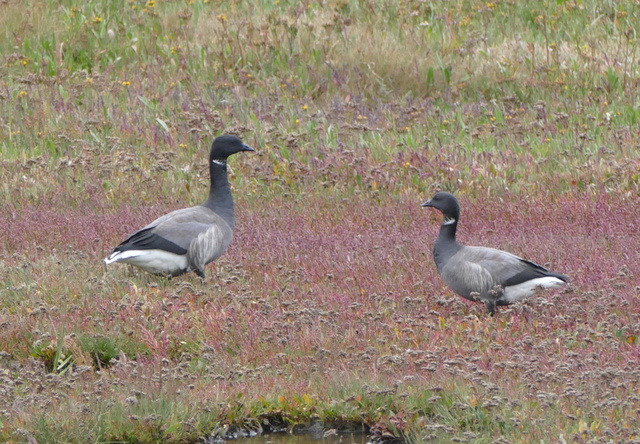 Brent Geese – when they first arrive, they all like to feed on the saltmarshes
Brent Geese – when they first arrive, they all like to feed on the saltmarshes
We could hear a couple of Goldcrests calling from the bushes, but couldn’t see them at first. They were obviously keeping down out of the wind. Then we came across a flock of Long-tailed Tits and two Goldcrests with them were more obliging. Still, there didn’t seem as many here as in recent days. We flushed a few Song Thrushes from the hedges as we walked, and a Redwing, but there was nothing to suggest any significant numbers had come in overnight. We were making our way back when a red tail flicked over a bush by the path and disappeared – presumably a Redstart, although it didn’t show itself again. As we stood and waited to see if it might reappear, a Blackcap hopped up to feed on the blackberries.
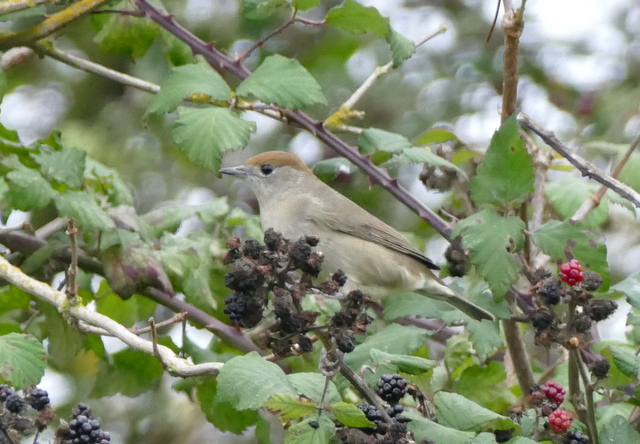 Blackcap – feeding on blackberries
Blackcap – feeding on blackberries
We had a quick look in campsite wood – and the place was absolutely alive with Goldcrests. We stopped to watch them dropping down out of the trees into the bushes out on the campsite to feed, then zooming back up into the trees again. There had been a report of a couple of Firecrests further along, in some trees on the edge of the campsite, but all the crests had moved on by the time we got there. While it was amazing to watch all the Goldcrests feeding feverishly, it was a struggle to see the birds in the canopy of the wood itself. Eventually, we decided to move on.
We made our way east along the coast to Beeston Common. There has been an Isabelline Shrike here for a couple of days already, and it has been a real performer. It was on form again today – perched high in the top of a hawthorn as we arrived, for all to see. We watched it in the scope for a while, then it set off on a sally out across the common, catching a bee and taking it back to the bush to incapacitate and then eat it.
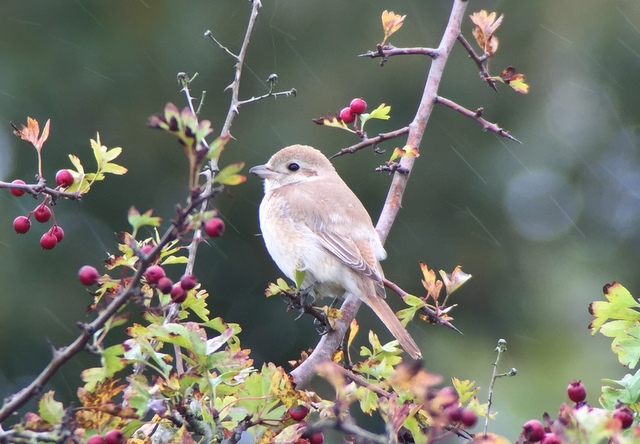 Isabelline Shrike – showing well at Beeston Common
Isabelline Shrike – showing well at Beeston Common
It flew around several times, moving between bushes, looking around all the time for prey. Even when it started to rain lightly at one point, it still sat up in the bushes. It was great to watch. Some video of it from yesterday is below.
After that crowd-pleasing performance, we had a short walk over the common to see what else we could see. There has been a Yellow-browed Warbler or two here in recent days, but we couldn’t find the tit flock today – it was just a bit too windy out there. We decided to head back to the car.
We drove to Cley and, after a stop at the Visitor Centre, we drove round to the beach car park. The morning had already gone, so we ate our lunch in the beach shelter out of the wind. While we were eating, we kept one eye on the sea. Seawatching can always produce interesting birds, with a decent onshore wind. There were plenty of Gannets going past today, adults with black-tipped white wings and lots of slaty-grey juveniles. And a steady stream of little groups of auks – mostly Guillemots, but we also picked up several blunt-billed Razorbills too.
 Gannet – one of the many juveniles past today
Gannet – one of the many juveniles past today
While we were eating, the vigilence paid off. We picked up a distant Sooty Shearwater flying past, alternately arcing up high over the sea and dipping down to skim low over the waves. We could see its dark underparts, ruling out the commoner Manx Shearwater. After we had finished eating and suitably emboldened by the shearwater, we decided to move round to the side of the shelter to have a more concerted effort at seawatching.
It certainly paid off! Next up, another Sooty Shearwater came past, much closer this time, giving us all a great view. Then a skua appeared low over the sea to our left, heading our way. We got it in the scope and could see that it was a Pomarine Skua and a super smart adult to boot. As it came past we could even see the ‘spoons’ – the elongated, spatulate central tail feathers which project out the back, characteristic of the species. Stunning! Then another shearwater appeared, a bit further out and this time keeping very low over the sea. It was fairly dark again, but shorter winged and dumpier than the Sooty. It was a Balearic Shearwater from the Mediterranean. To round things off nicely, a Great Skua flew past us next – big, bulky & dark, with steady and deliberate wingbeats. We hadn’t intended to seatwatch today, and only gave it about half an hour, so this was an amazing return. If only every day seawatching could be as good as this!!
There was still no real sense of any major new influx of passerines on the wind, so we decided to make our way back to Holkham to try to catch up with the star bird there – a Red-flanked Bluetail which had been found lurking in some dense sallows yesterday. We parked at Lady Anne’s Drive and made our way west along the inner edge of the pines. We were serenaded by the yelping of Pink-footed Geese as we walking. At Salts Hole, we stopped to admire the Little Grebes. At least 5 today, there was lots of territorial chasing going on and lots of maniacal laughter.
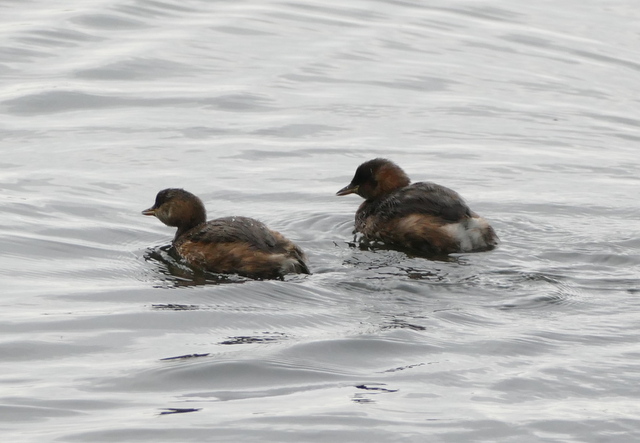 Little Grebe – one of the pairs at Salts Hole
Little Grebe – one of the pairs at Salts Hole
A little further along, we heard a Marsh Tit calling. We could see it moving around in the low elm suckers alongside the path. It was fascinating to watch – it pulled a dried leaf from one of the trees and took it to a nearby perch, where it starting pecking at the leaf violently. It gradually became clear that the leaf was curled over and after a second or two the Marsh Tit pulled out a caterpillar. It had obviously cocooned itself into a leaf, but the Marsh Tit had realised it was hiding in there and had taken the leaf off to extract it. Very clever.
We detoured up the boardwalk by Washington Hide. The trees here can be very good for birds, but it was just too exposed and gusty there today and they were quiet, apart from yet more Goldcrests. We stopped to look at a small party of Pink-footed Geese out on the grazing marshes. In the bushes down on the edge of the reedbed, several Redwings were feeding on berries. A Sparrowhawk flew in and landed in a hawthorn, looking round hungrily.
The pool in front of Washington Hide was fairly empty today, and we were just walking back down the boardwalk when a large white shape started to take off from one of the ditches just to the east. The Great White Egret had obviously been hiding in there, out of view, today. We watched it fly across and then drop down into another ditch further over, out of view again.
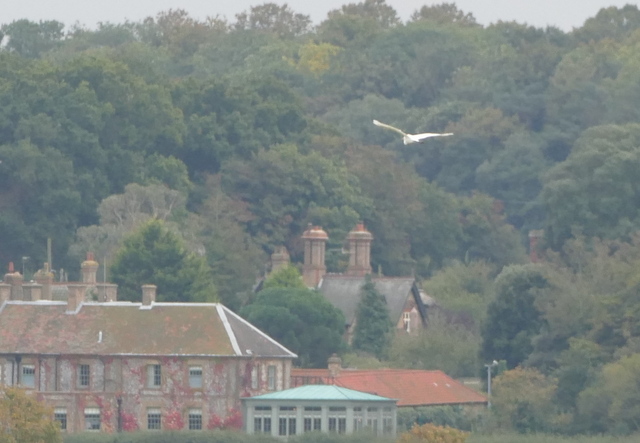 Great White Egret – flying between ditches this afternoon
Great White Egret – flying between ditches this afternoon
We continued our way west, stopping occasionally to watch the tit flocks or the Goldcrests coming down to bathe in a puddle. A very white Common Buzzard has returned to the bushes over by the church – it was there last winter and was causing some confusion again today.
There is always lots to see here, but we had really come hoping to see the Red-flanked Bluetail and time was getting on, so we made our way to the trees where it had been showing. We hadn’t been there long, when it suddenly appeared from the sallows behind and started to feed on the brambles. We could see the bright blue tail as it flicked around on the bushes, and the deep orange flank patches. Once an almost mythical rare visitor here, they are now turning up more often, but are still an absolute delight to see.
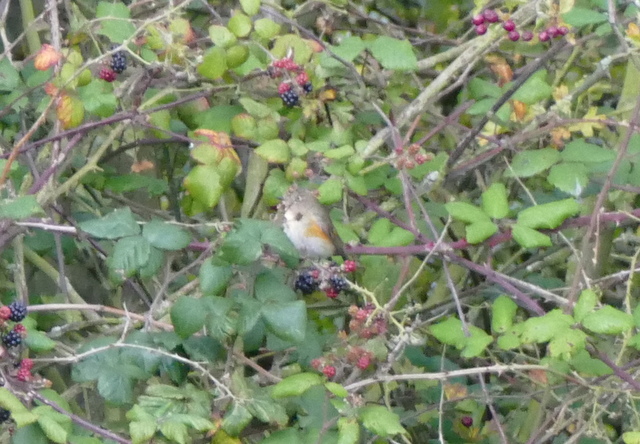 Red-flanked Bluetail – a record shot in poor light this afternoon
Red-flanked Bluetail – a record shot in poor light this afternoon
It has been hassled repeatedly by the local Robins and obviously didn’t fancy spending too long out in the open, so darted back into the sallows. Having seen it so easily, we hung around a short while to see if we could see it again. Unfortunately, it wasn’t to be. However, while we were waiting we did hear a Yellow-browed Warbler calling loudly from the sallows. When a bird appeared on the edge of the sallows immediately after, we thought that would be it – but it turned out to be a Firecrest instead. It didn’t stay long and disappeared back into the bushes.
We didn’t have time to linger too long, so set off back to the car. We still had time for one last bird – on our way back, another Firecrest had been seen in the holm oaks beside the path. We arrived just in time to see it flicking around amongst the branches, before it suddenly darted out and disappeared into the trees behind.
It was time to call it a day, but it had been a great Autumn day out – with some top quality rare visitors and a classic seawatching session in the middle!
















